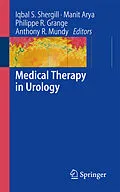Medical Therapy in Urology is a concise and practical guide to the medical management of urological diseases. Bridging the gap between primary and secondary care, it provides clinicians in an outpatient setting, including family practitioners, with the information needed for the initial medical management of urological conditions.
The editors and authors bring a wealth of experience in Urology to ensure that the primary care practitioner is completely equipped to initiate the treatment and management of all manner of urological conditions. Each chapter includes a brief overview of the relevant anatomy, physiology and pathology of the condition in question, an explanation of the drugs used , a review of medical literature and a clinical section on when a particular drug treatment should be used.
Consultant Urologists, Uro-radiologists, medical clinicians and family practitioners alike will find this succinct overview a valuable resource in their day-to-day practice.
Zusammenfassung
The future of urology is changing from one based around surgery, to an outpatient system, concentrating mainly on medical mana- ment. Last year, in the UK, there were almost two million hospital consultations for urological symptoms and an estimated fve million consultations in general practice. With such a signifcant proportion of care being delivered for urology, 80% of which can be managed medically, we felt that a resource should be made available to providers that will serve as a quick and useful guide to the medical management of urological disease. The aim was to provide a fresh, practical, and concise overview of the key medical management issues every practicing clinician faces in an outpatient urology setting, on a daily basis. With these goals in mind, each chapter starts with a brief overview of the relevant anatomy/physiology and pathology of the condition in question, and then goes on to give an explanation of the drugs used, including mode of action, doses, side effects, and important interactions/contraindications. Finally, there is a brief but relevant section on review of medical literature and a clinical section on when a particular drug treatment should be used. A list of key points can be found at the end of each section.
Inhalt
Bladder Cancer.- Renal Cell Cancer.- Prostate Cancer.- Testicular Cancer.- Penile Cancer.- LUTS/Benign Prostatic Hyperplasia.- Overactive Bladder and Incontinence.- Urinary Tract Infections.- Bladder Pain Syndrome/Interstitial Cystitis.- Chronic Prostatitis/Chronic Pelvic Pain Syndrome.- Urinary Tract Stones.- Erectile Dysfunction.- Male Hypogonadism.- Renal Transplantation.- Analgesia for Urological Procedures.- Alternative or Complementary Treatments in Urology.
